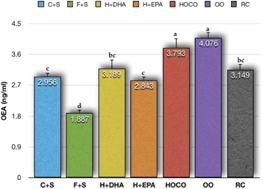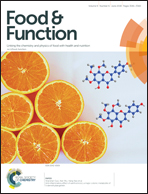Dietary fatty acid composition impacts plasma fatty acid ethanolamide levels and body composition in golden Syrian hamsters
Abstract
Fatty acid ethanolamides (FAEs) are a class of lipid amides that regulate numerous pathophysiological functions. To date, pharmacological research in this area has focused on the endocannabinoid system, metabolic pathways, and biological significance of FAEs; however, limited nutritional studies have been conducted to understand the actions of FAEs on food intake and their role on overall body composition. Therefore, the present study was designed with the hypothesis that high C18:1n9 will attenuate food consumption in golden Syrian male hamsters (n = 105). Moreover, the long-term (two months) effects of feeding hamsters various dietary oil blends, namely, C+S, 25:75 corn oil:n9 safflower oil; F+S, 25:75 flaxseed oil:n6 safflower oil; H+DHA, 85:15 high oleic canola oil:docosahexaenoic acid; H+EPA, 85:15 high oleic canola oil:eicosapentaenoic acid; HOCO, high oleic canola oil; OO, olive oil; and RC, regular canola oil, on the plasma levels of seven different FAEs and fatty acids (FAs) composition were investigated. A further objective was to characterize the actions of these diets on energy expenditure and overall body composition to determine if dietary fatty acid (DFA) composition affects diet-induced obesity (DIO). The results show that DFA directly influenced plasma FA and FAE levels, with marked increases (p < 0.05) observed in plasma C18:1n9 levels after HOCO and OO treatments. Correspondingly, the most elevated plasma oleoylethanolamide (OEA) levels were observed with HOCO and OO treatments, which also decreased (p < 0.05) food intake by ∼8% when compared with H+EPA dietary treatment when measured at the endpoint. Diminished food intake subsequent to HOCO and OO feeding may have resulted from increased OEA concentrations, demonstrating the anorexic properties of the high C18:1n9 dietary components. No differences were observed across OO, HOCO, and HOCO diets with omega-3 FA blends in terms of body composition, energy expenditure, plasma C18:1n9 levels, or OEA concentrations. Based on these findings, we conclude that the addition of HOCO to diets aids in the reduction of food intake, which may contribute to the maintenance of healthy body weight.



 Please wait while we load your content...
Please wait while we load your content...